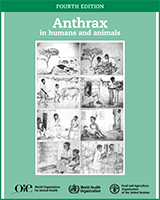All rights reserved. Publications of the World Health Organization can be obtained from WHO Press, World Health Organization, 20 Avenue Appia, 1211 Geneva 27, Switzerland (tel.: +41 22 791 3264; fax: +41 22 791 4857; e-mail: tni.ohw@sredrokoob). Requests for permission to reproduce or translate WHO publications – whether for sale or for noncommercial distribution – should be addressed to WHO Press, at the above address (fax: +41 22 791 4806; e-mail: tni.ohw@snoissimrep).
NCBI Bookshelf. A service of the National Library of Medicine, National Institutes of Health.
Anthrax in Humans and Animals. 4th edition. Geneva: World Health Organization; 2008.
Chapter 2.2.1 Anthrax
Article 2.2.1.1
There is no evidence that anthrax is transmitted by animals before the onset of clinical and pathological signs. Early detection of outbreaks, quarantine of affected premises, destruction of diseased animals and fomites, and implementation of appropriate sanitary procedures at abattoirs and dairy factories will ensure the safety of products of animal origin intended for human consumption.
For the purposes of the Terrestrial Code, the incubation period for anthrax shall be 20 days.
Anthrax should be notifiable in the whole country.
Standards for diagnostic tests and vaccines are described in the Terrestrial Manual.
Article 2.2.1.2
Veterinary authorities of importing countries should require:
for ruminants, equines and pigs
the presentation of an international veterinary certificate attesting that the animals:
- showed no clinical sign of anthrax on the day of shipment;
- were kept for the 20 days prior to shipment in an establishment where no case of anthrax was officially declared during that period; or
- were vaccinated, not less than 20 days and not more than 6 months prior to shipment.
Article 2.2.1.3
Veterinary authorities of importing countries should require:
for products of animal origin (from ruminants, equines and pigs) intended for agricultural or industrial use
the presentation of an international veterinary certificate attesting that the products:
- originate from animals not showing clinical signs of anthrax; or
- have been processed to ensure the destruction of both bacillary and spore forms of Bacillus anthracis in conformity with one of the procedures referred to in Appendix X.X.X. (under study).
Article 2.2.1.4
Veterinary authorities of importing countries should require:
for fresh meat and meat products destined for human consumption
the presentation of an international veterinary certificate attesting that the products originate from animals which:
- have shown no sign of anthrax during antemortem and postmortem inspections;
- come from establishments which are not placed under quarantine on account of anthrax control and in which:
- there has been no case of anthrax during the 20 days prior to slaughter;
- no vaccination against anthrax has been carried out during the 42 days prior to slaughter.
Article 2.2.1.5
Veterinary authorities of importing countries should require:
for hides, skins and hair (from ruminants, equines and pigs)
the presentation of an international veterinary certificate attesting that the products originate from animals which:
- have shown no sign of anthrax during antemortem and postmortem inspections;
- come from establishments which are not placed under quarantine on account of anthrax control.
Article 2.2.1.6
Veterinary authorities of importing countries should require:
for wool
the presentation of an international veterinary certificate attesting that the products:
- originate from animals showing no clinical signs of anthrax at the time of shearing;
- originate from establishments where no case of anthrax has been reported since the previous shearing of all animals.
Article 2.2.1.7
Veterinary authorities of importing countries should require:
for milk and milk products intended for human consumption
the presentation of an international veterinary certificate attesting that the products:
- originate from animals showing no clinical signs of anthrax at the time of milking; or
- were processed using a heat treatment at least equivalent to pasteurization (under study).
Footnotes
- 1
Terrestrial Animal Health Code. Paris, World Organisation for Animal Health (OIE), 2007 (http://www
.oie.int/eng /normes/mcode/en_chapitre_2 .2.1.htm#rubrique_anthrax).
- Terrestrial Animal Health Code - Anthrax in Humans and AnimalsTerrestrial Animal Health Code - Anthrax in Humans and Animals
- 2410004B18Rik RIKEN cDNA 2410004B18 gene [Mus musculus]2410004B18Rik RIKEN cDNA 2410004B18 gene [Mus musculus]Gene ID:66421Gene
- Gene Links for GEO Profiles (Select 129915643) (1)Gene
- Same Parent, Connectivity for PubChem Compound (Select 169501860) (1)PubChem Compound
- Mus musculus zinc finger CCCH type containing 7 A (Zc3h7a), transcript variant 1...Mus musculus zinc finger CCCH type containing 7 A (Zc3h7a), transcript variant 1, mRNAgi|1558870901|ref|NM_145931.3|Nucleotide
Your browsing activity is empty.
Activity recording is turned off.
See more...
